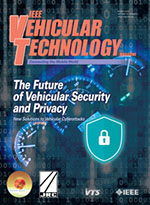|
 The forthcoming fifth-generation (5G) mobile wireless system is likely to lead to an increasingly heterogeneous data-demand pattern, including a small number of high-data-rate mobile broadband links and a large number of low-data-rate Internet of Things (IoT) applications. The forthcoming fifth-generation (5G) mobile wireless system is likely to lead to an increasingly heterogeneous data-demand pattern, including a small number of high-data-rate mobile broadband links and a large number of low-data-rate Internet of Things (IoT) applications.
Aspects that govern seamless mobility between different access technologies, cell tiers, cell sectors, and frequency bands will be sensitive to the mobility model of the people, their devices, and the machines. An understanding of such entities will play a fundamental role in the future standardization and exploitation of the 5G technologies.
In this article, we provide a comprehensive and general overview about existing mobility models that are useful to characterizing movement patterns across multiple distance and population scales. In doing so, all the models are critically discussed, providing strengths and weaknesses. Finally, open issues and critical design choices are highlighted to serve as guidelines for future research on this topic.
The growing demand for a fully mobile and connected wireless ecosystem is driving the telecommunications operators toward the hard task of managing existing services and planning new ones to meet the tremendous growth in both the traffic density and the number of connected devices.
It is evident today that the mobile/cellular ecosystem is evolving to something that is highly dynamic and flexible. This concerns not only the network infrastructure and equipment but also the actors that take part over the system landscape.
Whereas current mobile network vehicles play the dominant role when talking about mobility, in future 5G cellular network systems, the difference between what is mobile, i.e., part of the infrastructure, and the end user will become more blurred. With the advent of the Internet of Everything (IoE) paradigm and new wireless technologies, e.g., device-to-device (D2D) communications, millimeter wave (mm-wave), and light fidelity (Li-Fi), there is the need for deep rethinking about what the impact of mobility on system performance will be.
The key standard to overcome the increasing demands of new multimedia services, applications, and connectivity has been identified as 5G. Therefore, the launch of a 5G standard will need to provide higher performance benefits, such as greater throughput, lower latency, ultrahigh reliability, higher connectivity, and higher mobility tolerance.
In addition to an envisaged high-density deployment, where different types of network nodes and wireless standards are deployed within the same area, a fundamental reconsideration about the design of mobility management and its application to future 5G scenarios is needed. The exploitation of the enhanced capability of network devices jointly with the context applications (and information) that they provide is expected to play a fundamental role in mobility modeling for future 5G systems.
Full article: IEEE Vehicular Technology Magazine, Volume 13, Number 1, March 2018 |